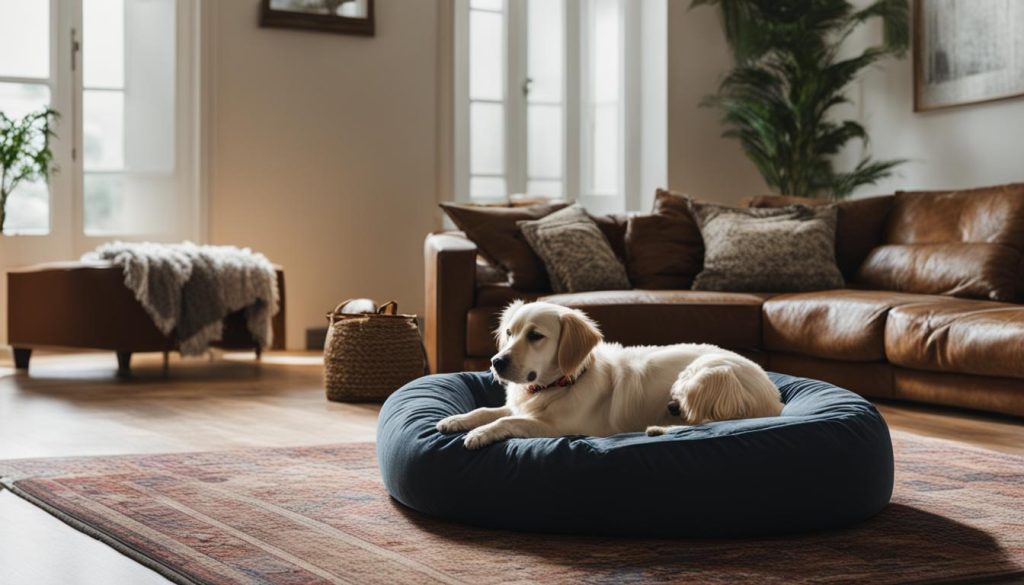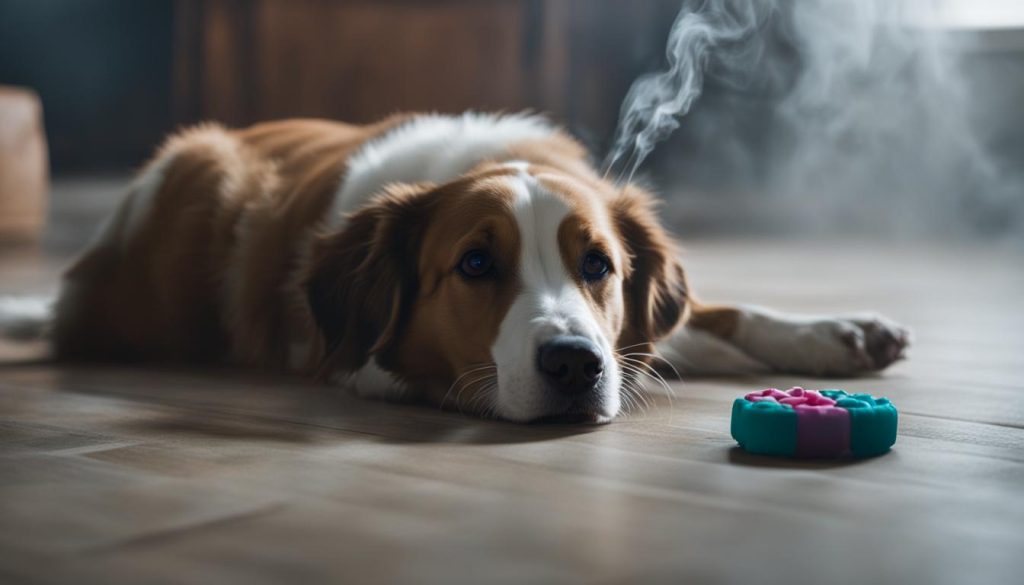If your dog gets overly excited or anxious when guests come to your home, teach them how to be calm and well-behaved. By implementing training exercises and creating a calm environment, you can ensure a stress-free and friendly atmosphere for everyone involved.
Key Takeaways:
- Teaching your dog to be calm with visitors requires patience and consistency.
- Brush up on basic training skills before focusing on calm behavior.
- Use positive reinforcement and rewards to encourage calm behavior during greetings.
- Communicate with your guests to ensure they understand the training process.
- Provide your dog with a safe space and provide distractions and calming tools.
Understanding the Importance of Training Tune-ups
Before diving into teaching your dog to be calm with visitors, please start with a solid foundation of basic training skills. Regular training tune-ups ensure that your dog maintains their obedience skills and self-control, setting them up for success in any situation.
Practicing obedience skills such as the sit command not only reinforces your dog’s ability to follow commands but also helps them develop self-control. By teaching your dog to sit and stay, you are teaching them to calm themselves down, which is essential when visitors come to your home.
Training tune-ups also provide an opportunity to address any areas where your dog may need improvement. For example, if your dog has a tendency to dash through open doors, practicing door manners during training sessions can help them understand the importance of waiting calmly.
By incorporating regular training tune-ups into your dog’s routine, you can reinforce their obedience skills and build a solid foundation of self-control, preparing them for the next step in their training journey.

Table: Comparison of Training Tune-up Techniques
| Technique | Benefits |
|---|---|
| Practicing obedience commands | Reinforces listening skills and self-control |
| Teaching door manners | Prevents rushing through open doors |
| Working in different environments | Helps dogs generalize their training to various situations |
| Using distractions | Builds focus and impulse control |
Table: Comparison of Training Tune-up Techniques
| Technique | Benefits |
|---|---|
| Practicing obedience commands | Reinforces listening skills and self-control |
| Teaching door manners | Prevents rushing through open doors |
| Working in different environments | Helps dogs generalize their training to various situations |
| Using distractions | Builds focus and impulse control |
The Six Steps to Train Your Dog to Greet Visitors
Once you and your dog have refreshed their training skills, you can move on to training appropriate greetings with visitors. The six steps outlined below will help you ensure a smooth and calm interaction.
- Recruit a helper: Enlist the assistance of a friend or family member to play the role of a visitor. This will allow you to practice the greeting process in a controlled environment.
- Using high-value treats: Prepare some delicious treats that your dog loves. These treats will serve as a reward for calm behavior during the greeting process.
- Leashing the dog: Before the visitor arrives, put your dog on a leash. This will give you more control and prevent any jumping or excessive excitement.
- Answering the door: When the doorbell rings or there’s a knock, instruct your dog to sit and stay. Reward them with a treat for maintaining a calm position.
- Rewarding calm behavior: As you open the door, continue to reward your dog for remaining calm. If they start to get excited, gently correct their behavior and redirect their attention back to you.
- Gradually progress: Over time, gradually increase the level of excitement during the greeting process. This can include having the helper offer a handshake or engage in a brief conversation. Try to reward your dog for staying calm throughout the interaction.
By following these six steps and consistently practicing them with different visitors, your dog will learn to greet guests in a calm and well-behaved manner. I recommend that you be patient and consistent in your training efforts, as every dog learns at their own pace. With time and practice, your dog will become a pro at greeting visitors with a wagging tail and a calm demeanor.
Table: Six Steps to Train Your Dog to Greet Visitors
| Step | Description |
|---|---|
| Recruit a helper | Enlist the assistance of a friend or family member to play the role of a visitor |
| Using high-value treats | Prepare some delicious treats that your dog loves to reward calm behavior |
| Leashing the dog | Put your dog on a leash before the visitor arrives for more control |
| Answering the door | Instruct your dog to sit and stay as you open the door and reward them for maintaining a calm position |
| Rewarding calm behavior | Continue to reward your dog for remaining calm throughout the greeting process |
| Gradually progress | Over time, increase the level of excitement during the greeting process and reward your dog for staying calm |
Teaching Your Guests to Ignore Your Dog During Training
When it comes to training your dog to be calm with visitors, it’s not just your dog that needs to be trained – your guests need some guidance too. By teaching your guests to ignore your dog during training sessions, you can avoid reinforcing rude behavior and redirect their attention to you, the owner.
Communication is key when it comes to instructing your guests. Let them know that your dog is currently in training and that it’s important for them to completely ignore your furry friend. This means no talking, petting, or feeding. By setting clear expectations and reinforcing the idea that all attention should come from you, you can ensure consistency in your dog’s training.
“During training sessions, it’s crucial that guests refrain from giving any attention to your dog. This helps your dog understand that the focus and interaction should be directed towards you,” suggests professional dog trainer, Jane Smith.
It’s all about creating an environment where your dog learns to associate calm behavior with positive reinforcement from you alone.
| Teaching Your Guests to Ignore Your Dog During Training |
|---|
| Provide clear instructions to your guests about the training process |
| Remind them to refrain from talking, petting, or feeding your dog |
| Communicate that all attention should come from you, the owner |
| Reinforce the idea that calm behavior leads to positive reinforcement |
“By teaching your guests to ignore your dog, you’re avoiding any accidental reinforcement of undesirable behaviors and redirecting their focus onto you as the leader,” explains Smith. To put it simply, consistency is key in training, so make sure all your guests are on board with this approach to ensure your dog’s progress and success.
Using Time Outs when Your Dog Gets Overexcited
If your dog becomes overly excited or overwhelmed with guests in your home, give them a time out. By providing a quiet and separate space, you allow your dog to calm down and regain their composure. Placing your dog in a crate or a separate room can help create a designated area for them to relax.
During the time out, it’s beneficial to provide your dog with treats or chew toys to help redirect their focus and keep them occupied. This not only helps to distract them from the excitement but also provides a positive and calming experience. Make sure to choose treats or chew toys that are safe and appropriate for your dog’s size and breed.
Gradually increase the duration of the time out as your dog becomes more comfortable and relaxed. Start with shorter periods, such as 5-10 minutes, and gradually extend it to 15-20 minutes. Monitor your dog’s behavior and body language during the time out to ensure they are responding positively.
| Benefits of Using Time Outs | Tips for Effective Time Outs |
|---|---|
|
|
Addressing Reactivity and Nervousness Towards Visitors
If your dog exhibits reactive or fearful behaviors towards visitors, please address these issues to ensure the safety of both your dog and your guests. Seeking help from a professional dog trainer or behaviorist can provide you with the guidance and expertise needed to navigate these challenging situations.
A professional dog trainer can assess your dog’s behavior and provide you with specific techniques and strategies to address aggression or fear. They will work with you to create an individualized training plan that focuses on building your dog’s confidence and helping them feel more comfortable around visitors.
Through positive reinforcement and desensitization exercises, a professional trainer can help your dog overcome their reactive or fearful responses. They will guide you in gradually exposing your dog to controlled and manageable situations with visitors, allowing them to learn new, more positive behaviors in a structured and supportive environment.

| BENEFITS OF SEEKING PROFESSIONAL HELP |
|---|
| Expert guidance and support |
| Individualized training plan |
| Positive reinforcement techniques |
| Gradual exposure to visitors |
| Building confidence and reducing fear |
Don’t forget that aggression or fear in dogs can be complex and require professional intervention. You should also prioritize the well-being of your dog and seek the help of an experienced trainer who can help you navigate these challenging behaviors.
Preparing Your Dog and the Environment for Visitors
When it comes to having guests over, preparing your dog and creating a calm environment is key to ensuring a positive experience for everyone involved. By taking a few simple steps, you can help your dog settle when visitors come and minimize any potential excitement or anxiety.
To start, providing your dog with exercise and mental stimulation before guests arrive can help burn off excess energy and make it easier for them to relax. Take them for a walk or engage them in playtime to help tire them out. This will also help redirect their focus and provide a positive outlet for any excitement or nervousness.
Creating a safe space for your dog is another important aspect of preparing for visitors. Set up a designated area where your dog can retreat from the excitement and have some quiet time. This can be a cozy corner with their bed or a crate, depending on what they are comfortable with. Make sure to make this space inviting by adding their favorite toys or blankets.
When guests arrive, minimize excitement by approaching the door calmly and giving your dog clear commands. This will help set the tone for their behavior during the visit. Avoid excessive talking or shouting, as this can contribute to heightened excitement. Instead, focus on maintaining a calm and relaxed atmosphere for your dog.

To put it simply, consistency is key when preparing your dog for visitors. By providing exercise and mental stimulation, creating a safe space, and minimizing excitement, you can help your dog settle and have a pleasant experience with guests.
Using Physical Barriers and Positive Distance
When it comes to teaching your dog to be calm with visitors, using physical barriers can be a valuable tool. Dog gates or barriers can help reduce the risk of unwanted physical contact between your dog and your guests, providing a sense of safety for everyone involved. This not only helps prevent any potential accidents or injuries but also allows your dog to observe from a comfortable distance.
To create positive associations with the presence of visitors, you can use treats for positive association. Toss treats away from you and gradually increase the distance, encouraging your dog to accept and become comfortable with some distance from visitors. This approach reinforces their calm behavior and helps them develop a positive perception of guests.
Reducing physical contact is important, especially if your dog tends to get overly excited or anxious around visitors. By creating distance and using physical barriers, you can help your dog maintain a sense of calm and prevent any inadvertent jumping or rough play. Try to always supervise any interactions between your dog and guests to ensure everyone’s safety and well-being.

Table: Comparing Different Types of Dog Gates
| Gates | Features | Pros | Cons |
|---|---|---|---|
| Pressure-Mounted Gates | Easy to install and remove, suitable for doorways | Convenient, no drilling required | May leave marks on walls, not suitable for stairways |
| Hardware-Mounted Gates | Screwed into the wall, suitable for stairways | Secure and sturdy | Requires drilling, may damage walls |
| Freestanding Gates | Stand on their own, portable | Easy to move around, no installation required | May not be suitable for larger dogs, less secure |
Using physical barriers and positive distance can be effective strategies to help your dog remain calm and well-behaved around visitors. By providing a safe and controlled environment, you can ensure a stress-free and enjoyable experience for both your dog and your guests.
Providing Distraction and Calming Tools
When it comes to helping your dog stay calm and relaxed with visitors, providing distraction and calming tools can be incredibly beneficial. These tools can help redirect your dog’s focus, alleviate anxiety, and create a soothing environment. Here are some effective methods to consider:
Long-Lasting Chews or Enrichment Toys
Providing long-lasting chews or enrichment toys can keep your dog engaged and occupied, especially during times when guests are present. These toys are designed to mentally stimulate your dog and provide a safe outlet for chewing behaviors. Look for durable options, such as puzzle toys or treat-dispensing toys, that can keep your dog entertained for extended periods.
Calming Sprays or Diffusers
Calming sprays or diffusers can help create a serene atmosphere in your home and reduce stress for your dog. These products typically contain pheromones or natural calming agents that can have a soothing effect. Simply spray the calming spray in the room where your dog spends most of their time or use a diffuser to continuously release calming scents.
Seeking Veterinary Help for Anxiety
If your dog experiences severe anxiety or struggles to remain calm even with the use of distraction and calming tools, it may be necessary to seek veterinary help. A veterinarian can assess your dog’s behavior, provide guidance on managing anxiety, and discuss potential medication options if necessary. Try to consult with a qualified professional to ensure you’re addressing your dog’s needs effectively.

By incorporating these distraction and calming tools into your routine, you can help create a more relaxed environment for your dog and improve their ability to handle visitors with ease.
Practicing Doorbell Training and Outside Meetings
In order to teach your dog how to remain calm when guests arrive, incorporate doorbell training into your routine. By desensitizing your dog to the sound of the doorbell and practicing without actual visitors, you can help them associate the sound with something routine and non-threatening.
Start by recording the sound of your doorbell and playing it at a low volume. Gradually increase the volume over time, making sure to reward your dog for remaining calm. Eventually, your dog will become more comfortable with the sound and less reactive when the doorbell rings.
Another helpful technique is to introduce your dog to new people outside of your home before allowing them inside. This can be done by meeting in a neutral location, such as a park or sidewalk. By doing this, your dog will have the opportunity to become familiar with new people in a less overwhelming environment, reducing their stress and anxiety.
Try to introduce new people gradually, starting with a brief interaction and gradually increasing the duration. Reward your dog for calm behavior and provide plenty of praise and treats to reinforce positive associations. This gradual approach will help your dog build trust and confidence when meeting new people.
| Doorbell Training and Outside Meetings | Benefits |
|---|---|
| Desensitizing to the doorbell sound | Helps your dog associate the sound with something routine and non-threatening |
| Meeting outside first | Allows your dog to become familiar with new people in a less overwhelming environment |
| Introducing new people gradually | Helps your dog build trust and confidence when meeting new people |
By practicing doorbell training and gradually introducing your dog to new people outside of your home, you can help them remain calm and well-behaved when visitors arrive. Try to be patient and consistent in your training efforts, and seek professional help if needed.

Final Thoughts
Teaching your dog to be calm with visitors is essential for creating a stress-free environment and ensuring a well-behaved dog around guests. By following the steps outlined in this article and seeking professional help when needed, you can effectively train your dog to greet visitors calmly and without anxiety.
Don’t forget that patience and consistency are key in this process. By refreshing your dog’s training skills, implementing training exercises, and creating a calm environment, you can set a solid foundation for your dog’s behavior around visitors. Practice obedience commands, such as sit and watch me, and teach your dog the importance of self-control, particularly when encountering open doors.
Recruiting a helper and gradually progressing through different training steps will enable your dog to learn appropriate greeting behavior. Instructing your guests to ignore your dog during training and avoiding reinforcement of rude behavior is crucial for consistency in your dog’s training. Additionally, providing time outs when your dog becomes overexcited and addressing reactivity or nervousness towards visitors are important aspects of this training process.
Preparing your dog and the environment for visitors by providing exercise and mental stimulation, creating a safe space, and minimizing excitement will help your dog settle when guests arrive. Using physical barriers and positive distance can reduce physical contact and help your dog become comfortable with some distance from visitors. Distraction and calming tools, such as long-lasting chews or enrichment toys, as well as calming sprays or diffusers, can also assist in creating a relaxed environment for your dog.
By practicing doorbell training, desensitizing your dog to the sound and introducing new people gradually, you can reinforce calm behavior when guests arrive. To put it simply, teaching your dog to be calm with visitors is a process that requires time and effort. By prioritizing the comfort of both your dog and your guests, you can create a stress-free environment and enjoy the company of a well-behaved dog around visitors.
FAQ
How can I teach my dog to be calm with visitors?
To teach your dog to be calm with visitors, practice obedience commands, reinforce self-control, and train appropriate greetings. Creating a calm environment, communicating with guests, and providing time outs when needed can also help.
What basic training skills should I focus on before teaching my dog to be calm with visitors?
Before teaching your dog to be calm with visitors, brush up on basic training skills. This includes practicing obedience commands such as sit and watch me, as well as teaching your dog not to dash through open doors.
How can I train my dog to greet visitors appropriately?
To train your dog to greet visitors appropriately, you can recruit a helper, have them ring the doorbell or knock on the door, and teach your dog to sit and stay while you answer the door. By rewarding calm behavior and gradually progressing through different training steps, your dog can learn to greet guests calmly.
How should I instruct my guests to behave around my dog during training?
I recommend that you communicate with your guests and let them know the training process. Instruct them to completely ignore your dog, including no talking, petting, or feeding. Reinforce the idea that all attention should come from you, as any attention from guests can reinforce unwanted behaviors.
What should I do if my dog becomes overly excited or overwhelmed with guests?
If your dog becomes overly excited or overwhelmed with guests in your home, give them a time out. Place them in their crate or a separate room with a treat or chew toy to help them calm down. This is not a punishment but rather a way for your dog to regain their composure in a quieter environment.
What should I do if my dog exhibits reactive or fearful behaviors towards visitors?
If your dog exhibits reactive or fearful behaviors towards visitors, it may be necessary to seek help from a professional dog trainer or behaviorist. They can assess the situation and provide specific techniques and strategies to address aggression or fear.
How can I prepare my dog and the environment for visitors?
To help your dog settle when visitors come, make sure to provide them with exercise and mental stimulation beforehand. Create a safe space for your dog where they can retreat from the excitement and provide them with engaging toys to keep them occupied. Minimize excitement by calmly approaching the door and giving your dog clear commands.
How can I use physical barriers and positive distance to help my dog with visitors?
Using physical barriers such as dog gates can help reduce the risk of unwanted physical contact between your dog and your visitors. You can also encourage positive associations by tossing treats away from you and gradually increasing the distance. This helps your dog accept and become comfortable with some distance from visitors.
Are there any tools I can use to help my dog stay calm with visitors?
When guests arrive, it can be helpful to provide your dog with distraction and calming tools. Long-lasting chews or enrichment toys can keep them engaged and help them relax. Calming sprays or diffusers can also create a soothing environment. If your dog has severe anxiety, it may be necessary to consult with a veterinarian for additional help, such as medications or behavioral therapy.
How can I train my dog to remain calm when the doorbell rings?
Doorbell training is important to help your dog remain calm when guests arrive. By desensitizing them to the doorbell sound and practicing with no visitors present, you can help them associate the sound with something routine. Additionally, meeting new people outside of the home can be easier for your dog to process, as the outdoor environment provides more distractions.
What is the key to teaching my dog to be calm with visitors?
Teaching your dog to be calm with visitors is a process that requires patience and consistency. By following the steps outlined in this article and seeking professional help when needed, you can create a stress-free environment and have a well-behaved dog around visitors.






